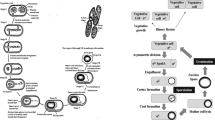Summary
The oxidative response to phagocytosis by chicken polymorphonuclear leucocytes was investigated as compared to guinea pig polymorphonuclear leucocytes.
The polymorphs from both species respond to phagocytosis with an increased oxygen consumption, an increased generation of O2 − and H2O2, and an increased oxidation of glucose through the hexose monophosphate shunt. The rate of oxygen consumption, and generation of O2 − and H2O2 by phagocytosing chicken polymorphonuclear leucocytes is considerably lower than with phagocytosing guinea pig polymorphonuclear leucocytes. By contrast, the extent of hexose monophosphate shunt stimulation in chicken polymorphs is comparable to that of guinea pig polymorphs. Evidence is presented suggesting that H2O2 is preferentially degraded in chicken cells through the glutathione cycle, whereas catalase and myeloperoxidase are the two main H2O2 degrading enzymes in guinea pig cells.
The 20,000 g fraction of the postnuclear supernatant of chicken polymorphs contains a cyanide-insensitive NADPH oxidizing activity which is stimulated during phagocytosis. Similar properties for the NADPH oxidizing activity of guinea pig polymorphs have been previously reported.
It is concluded that the metabolic burst of phagocytosing chicken polymorphonuclear leucocytes is qualitatively similar to that of guinea pig polymorphonuclear leucocytes, but the latter cells are more active in all the biochemical parameters that have been measured. The difference in the H2O2 degradation pathways between the two species is accounted for by the lack of myeloperoxidase and catalase in chicken polymorphs.
Similar content being viewed by others
References
Zatti, M. and Rossi, F., 1968. Experientia 24, 669–670.
Homan-Müller, J. W. T., Weening, R. S. and Roos, D., 1975. J. Lab. Clin. Med. 85, 198–207.
Root, R. K., Metcalf, J., Oshino, N. and Chance, B., 1975. J. Clin. Invest. 55, 945–955.
Babior, K. M., Kipnes, R. S. and Curnutte, J. T., 1973. J. Clin. Invest. 52, 741–744.
Weening, R. S., Wever, R. and Roos, D., 1975. J. Lab. Clin. Med. 85, 245–252.
McCord, J. M. and Fridovich, I., 1969. J. Biol. Chem. 244, 6049–6055.
Pennial, R. and Spitznagel, J. K., 1975. Proc. Nat. Acad. Sci. USA 72, 5012–5015.
Patriarca, P., Dri, P., Kakinuma, K. and Rossi, F., 1976. Molec. and Cell Biochem. 12, 137–146.
Patriarca, P., Cramer, R., Marussi, M., Moncalvo, S. and Rossi, F., 1971. J. Reticuloendothel. Soc. 10, 251–268.
Thurman, R. G., Ley, H. G. and Scholz, R., 1972. Eur. J. Biochem. 25, 420–430.
Dri, P., Bellavite, P. and Rossi, F., 1978. Molec. and Cell Biochem. In press.
Bray, G. A., 1960. Anal. Biochem. 1, 279–285.
Patriarca, P., Cramer, R., Moncalvo, S., Rossi, F. and Romeo, D., 1971. Arch. Biochem. Biophys. 145, 255–262.
Rossi, F. and Zatti, M., 1966. Biochim. Biophys. Acta 121, 110–119.
Rossi, F., Zabucchi, G. and Romeo, D., 1975. In Mononuclear Phagocytes in Immunity, Infection and Pathology (Van Furth, R. ed.) pp. 441–462, Blackwell Scientific Publications, Oxford.
Rossi, F., Romeo, D. and Patriarca, P., 1972. J. Reticuloendothel. Soc. 12, 127–149.
Bellavite, P., Dri, P., Bisiacchi, B. and Patriarca, P., 1977. FEBS Lett. 81, 73–76.
Breton-Gorius, J., Coquin, Y. and Guichard, J., 1978. Lab. Invest. 38, 21–31.
Iyer, G. Y. N., Islam, M. F. and Quastel, J. H., 1961. Nature (London) 192, 535–541.
Klebanoff, S. J. and Pincus, S. H., 1971. J. Clin. Invest. 50, 2226–2229.
Klebanoff; S. J. and Hamon, C. B., 1972. J. Reticuloendothel. Soc. 12, 170–196.
Brune, K. and Spitznagel, J. K., 1973. J. Infect. Dis. 127, 84–94.
Rausch, P. G. and Moore, T. G., 1975. Blood 46, 913–919.
Rossi, F., Patriarca, P. and Romeo, D. 1971. In the Reticuloendothelial System and Immune Phenomena (Di Luzio, N.R. ed.) pp. 191–208; Plenum Press, New York and London.
Patriarca, P., Cramer, R. and Dri, P., 1977. In Movement, Metabolism and Bactericidal Mechanisms of Phagocytes (Rossi, F., Patriarca, P. and Romeo, D. eds.) pp. 167–174, Piccin Editore, Padua and London.
Rossi, F. and Zatti, M., 1964. Brit. J. Exp. Pathol. 45, 548–559.
Romeo, D., Zabucchi, G., Soranzo, M. R. and Rossi, F., 1971. Biochem. Biophys. Res. Commun. 45, 1056–1061.
Author information
Authors and Affiliations
Rights and permissions
About this article
Cite this article
Dri, P., Bisiacchi, B., Cramer, R. et al. Oxidative metabolism of chicken polymorphonuclear leucocytes during phagocytosis. Mol Cell Biochem 22, 159–166 (1978). https://doi.org/10.1007/BF00496242
Received:
Issue Date:
DOI: https://doi.org/10.1007/BF00496242




